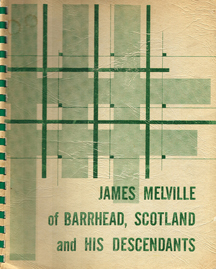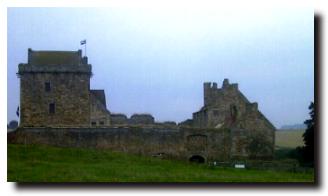A Melville Family
 |
This site is dedicated to James Melville, who emigrated from Barrhead, Scotland, in 1830, and to his numerous American descendants. Check out our family tree for a graphic view of our branch of the descendancy. Visit the famous Melvilles page for a list of how this small family has impacted history and the arts. For a snapshot of our branch of the Melvilles in America view this online genealogy. |
Clan History
The name originated from the barony of Malaville or Malleville in the Pays de Caux in Normandy. Guillame (William) de Malleville accompanied William the Conqueror to England and fought at the Battle of Hastings. Like many of major Scottish families, the de Mallevilles came to Scotland with King David I when he returned in 1124 after 30 years spent at the English court. They were granted lands in Midlothian, outside Edinburgh by King David. The first record of the name was as a witness to a charter granted by Malcolm IV, later in the 12th century. Galfrid de Maleville was a guardian of Edinburgh Castle in Malcolm's reign. A Richard Maluvell was one of those captured with King William at the Battle of Alnwick in 1174. Richard Maluvell's grand-daughter inherited the Barony of Melville which passed to the Ross family when she married Sir John Ross of Halkhead and the barony remained in that family until 1705.
Members of the family spread across Scotland and there are a number of documents with their signatures during the 12th and 13th century. When King Edward I of England demanded that all Scottish landowners and clergy should render homage to him and sign the "Ragman Rolls" in 1296, there were signatures from no less than twelve "Maleuill" (and other variant spellings), from as far afield as Edinburgh, Aberdeen, Stirling, Fife, Roxburgh and Peebles. Sir Johannes Maleuill, who signed the Rolls, was one of the major barons of Scotland at that time. His descendant, Sir John Melville of Raith was a favourite of King James V in the 16th century and obtained lands at Murdocairnie in Fife. Despite the royal patronage, he was an early supporter of the religious Reformation. As a friend of some of those who conspired to kill Cardinal Beaton of St Andrews, he was subsequently executed in 1550 on the evidence of a forged letter.
Sir Robert Melville of Murdocairnie was the keeper of the Palace of Linlithgow at the end of the reign of Mary Queen of Scots. Twenty years later, as an ambassador at the court of Queen Elizabeth, he was so outspoken about the sentence of death which had been pronounced on Mary by an English court, that he was threatened with imprisonment, despite his diplomatic status. Later, he became Vice-Chancellor of Scotland and took the title "Lord Murdocairnie". In 1616 he was created Baron Melville of Monymail. His son, also a judge, was given the title Lord Monymail in 1627 by King Charles I.
The fourth Lord Melville, a staunch Protestant, supported an unsuccessful rebellion by James, Duke of Monmouth, the illegitimate son of King Charles II. He had to flee abroad but returned with Queen Mary and William of Orange and became Secretary of State for Scotland and the first Earl of Melville. Despite trying to exercise a moderating influence on the conflict between the presbyterian and episcopal factions, there was nevertheless a witch-hunt of episcopalian ministers by the Church of Scotland. He married the granddaughter of the Covenanting general, Sandy Lesley and through his wife inherited the title of the earldom of Leven and the Castle of Balgonie in Fife (pictured here). Subsequent heirs have held the courtesy title of Lord Balgonie.
The family seat is Glenferness in Nairn. Melville Castle in Lothian, the original family home, was rebuilt by the Dundas family who took the title "Viscount Melville" although they have no connection with the Melville line.
The Melville clan has two mottoes - "Pro rege et patria" which means "For King and Country" and "Denique Coelum" which means "Heaven at last".
